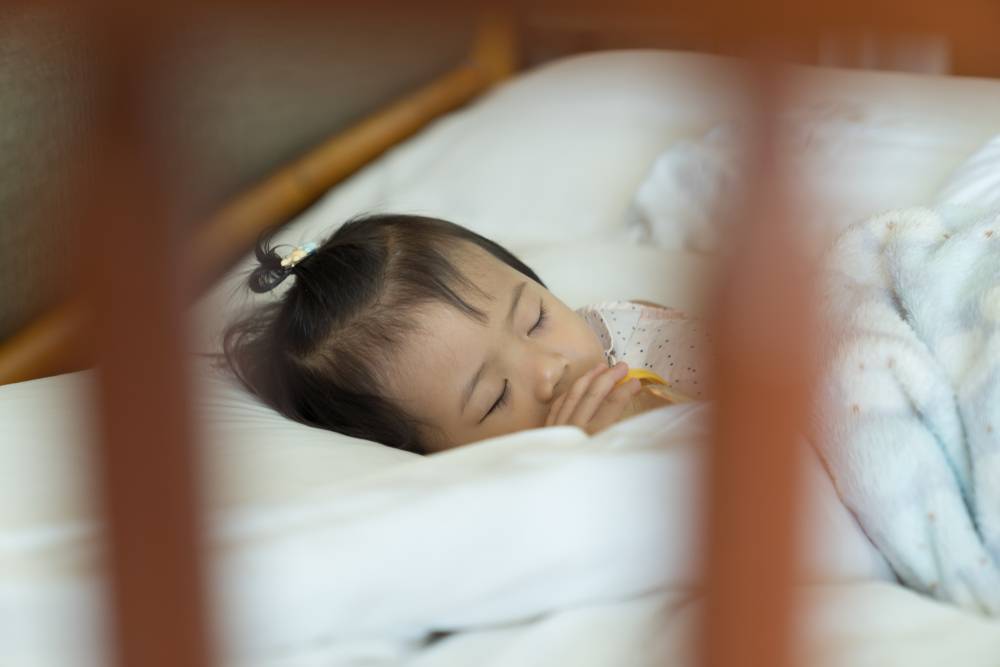Positional asphyxia refers to a condition when babies cannot breathe because the position of their body blocks their airway.
When airways are blocked, babies die quickly within a few minutes. The Singapore State Coroner recently ruled that the death of a four-month-old baby was a misadventure: the baby was put to bed for the night on a full-size bed and died of asphyxiation after falling into a gap. Amid another tragic accident, what are the safety measures for parents to take note of?
How does positional asphyxia occur?
As mentioned above, the condition occurs when the baby’s body position interferes with its ability to breathe properly. Babies, especially newborns and infants are particularly vulnerable to the condition due to their small size, immature neck muscles and inability to reposition themselves. One of the most common situations where this happens in babies is when they are asleep. For example, placing a baby on their stomach to sleep (prone position) or with their face covered by a soft object, such as a pillow or blanket, can increase the risk of positional asphyxia. In addition, babies can inadvertently get trapped in gaps or crevices, such as between the mattress and the crib, which can lead to positional asphyxia if their airway becomes compressed.
Other than during the night sleep in bed, positional asphyxia also occurs frequently in the car. Leaving a baby unattended in a car seat or an infant carrier for extended periods or using car seats that are not installed or used correctly can lead to positional asphyxia. The semi-reclined position in a car seat, combined with the angle of the head and neck, can cause the airway to become blocked.
How to prevent it?
Safe sleeping habits for babies set up by the parents are key:
- Always place baby on their back to sleep: The American Academy of Paediatrics (AAP) recommends that babies be placed on their back to sleep for every sleep, including naps and at night, until they are at least 1 year old. This helps reduce the risk of positional asphyxia.
- Use a firm and flat sleep surface: Babies should sleep on a firm and flat mattress that fits snugly into the crib or bassinet, without any soft bedding or padding underneath them. Avoid using soft mattresses, waterbeds, pillows, or other cushioned surfaces, as they can increase the risk of suffocation.
- Keep baby’s sleep area clear of hazards: The sleep environment should be free of loose blankets, pillows, stuffed animals, bumper pads, and other objects that could pose a suffocation or strangulation risk. A fitted sheet is the only bedding that should be used in the crib.
- Share the same room, but not the same bed: The AAP recommends room-sharing, where the baby sleeps in a crib, bassinet, or play yard close to the parents’ bed, but not in the same bed. Bed-sharing has been associated with an increased risk of positional asphyxia and other sleep-related incidents.
- Avoid using sleep positioners: despite the claim from companies that they can help reduce the risk of position-related suffocation, it has resulted in 12 infant death during a 13-year span according to a warning issued by the FDA in 2010.
Last but not least, while driving, install the baby seat correctly following the instructions. Adjust the straps to make sure they are comfortable and safe, and always make sure there’s someone keeping an eye on them throughout the journey.
How to resuscitate?
This is the least place the parents would like to find themselves in. However, if you suspect a baby might be experiencing positional asphyxia with signs like difficulty breathing, pale or bluish face/lips, unable to move etc, call for help immediately. After calling for help or getting someone to call for help, here are the steps to follow to maximize the chance of their survival:
- Release the baby from the position: If the baby is trapped or restrained in a position that is causing the asphyxia, carefully and quickly release the baby from that position to allow for normal breathing. Be gentle and cautious to avoid causing any further harm or injury to the baby.
- Open the airway: Place the baby on a firm surface, such as the ground or a hard surface, with the head tilted back slightly to open the airway. Use a head tilt and chin lift technique to ensure the airway is clear and unobstructed.
- Check for breathing: Look, listen, and feel for signs of normal breathing, such as chest rise, air movement, and breath sounds. Do this for no more than 10 seconds.
- Perform CPR: If the baby is not breathing or is gasping for breath, start CPR (cardiopulmonary resuscitation) immediately. CPR for infants typically involves giving chest compressions and rescue breaths in a ratio of 30 compressions to 2 breaths. Follow the CPR guidelines recommended by the American Heart Association (AHA) or your local medical authority.
- Continue CPR until the ambulance arrives.
Proper CPR and other first-aid pieces of training are offered in many institutions. Check with your local communities to sign up. If you are not trained in CPR, the emergency dispatcher can also provide instructions over the phone. Remember to stay calm, act quickly, and seek professional medical help as soon as possible.

